
Sapphire X800 XT
Written by John Yan on 10/14/2004 for
PC
More On:
Sapphire X800 XT
ATI’s line of high end graphics cards has another entry as today we are taking a look at the X800 XT from Sapphire. The card is situated between the X800 Pro and the X800 Platinum Edition. While we haven’t really seen a good amount of PE cards, we should be seeing more of the X800 XT cards in circulation.

The X800 XT from Sapphire is a pretty vanilla card. I’d like to see the Toxic treatment given to this card but right now the only one available is the regular edition. Looking at the card, it would be hard pressed to see the differences between the XT and Pro edition if not for the fact that on the back of the card, there is a small sticker specifying that it is an XT model. The cooling solution is pretty standard here as well.
As far as the specifics of the card, the X800 XT features the full 16 pipes unlike the 12 pipes that is available in the X800 Pro card. Clock frequencies are at 500MHz core and 500MHz memory. Speeds are moderately less than the Platinum Edition and you can see the comparison below along with the X800 Pro in the picture.
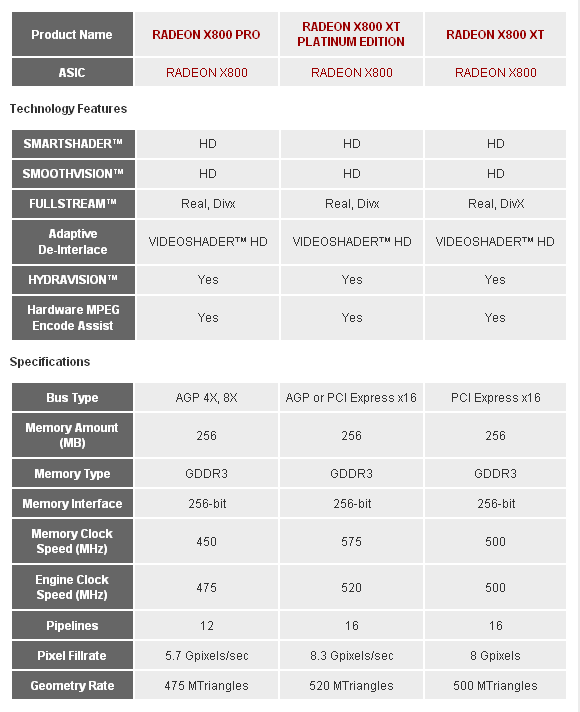
One of the nice things about Sapphire’s offerings are the bundles and the X800 XT card I received features their latest bundle that wasn’t in the initial X800 Pro card that Sapphire sent me. Two great games, Splinter Cell: Pandora Tomorrow and Prince of Persia: Sands of Time are included along with a good software suite. That’s two well received game that’s a great addition to anyone’s library.
AMD64 3200+
2 - 256MB PC3200 ram from Crucial
ABIT KV8-MAX3 motherboard
Maxtor 200GIG 7200 RPM harddrive
Windows XP Professional with Service Pack 1
Catalyst 4.9
For this review I’m going all game benchmarks, no synthetic benchmarks. First up will be a new one to our lineup: Doom 3

Doom 3 is iD Software’s re-invention of the classic game that started the deathmatch craze. The engine really taxes a system and the graphics are phenomenal for a computer game. For the tests, we ran the game with Max settings here.
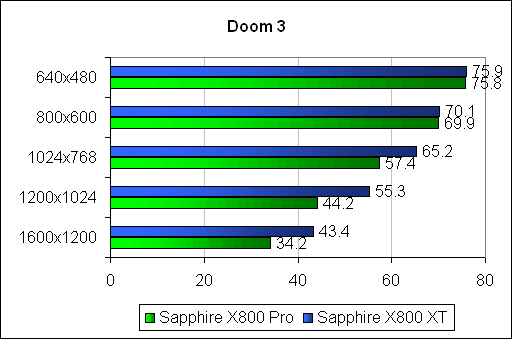
While the bottleneck is the CPU at 640x480 with both cards running neck and neck, you can see the X800 XT’s power show as we increase the resolution. The X800 XT runs almost 10fps more at 1600x1200 than the X800 Pro.

Far Cry is an impressive first person shooter from Ubi Soft with great outdoor levels and some awesome effects. The vehicles and the ability to explore the entire island makes this one of the best games of the past year. Settings were maxed out and we used the default demo.
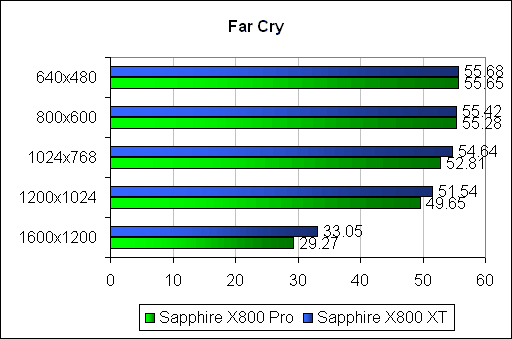
At low resolutions, the two cards are running at pretty much the same speed. Only when we start upping the resolution do we see the X800 XT pull away.

Halo is the Microsoft/Bungie/Gearbox first person shooter originally appearing on the Xbox. Featuring great graphics, vehicles, and good gameplay Halo is ran with max settings as well with Pixel Shader 2.0.
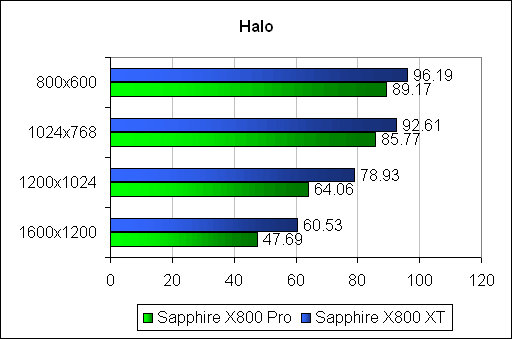
The X800 XT keeps an average of 60 fps at 1600x1200 and almost keeps pace with the X800 Pro running at 1280x1024.

If there’s one game I really enjoyed the past year it’s Call of Duty. The squad combat and action really excelled in this game. For this test, the settings were set at max and we ran the default demo in the various resolutions.
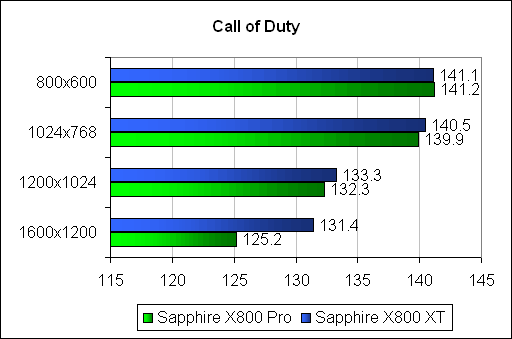
There really isn’t much separating the two cards as the game looks like it’s more CPU dependent at this point.

Epic’s great shooter, Unreal Tournament 2004 is our next test. While the engine didn’t change too much from the previous version, it’s still a very nice looking game. Three bot matches were ran with the scores averaged for each resolution. Details were maxed out.

Like with Call of Duty, both cards ran the game pretty well and scores were close to each other. We should see a difference between this and Call of Duty as we move into the anti-aliasing and anisotropic filtering tests later in this review.

Our final test is Splinter Cell from Ubi Soft. The third person stealth game uses a modified Unreal engine. Default demo was used for this test and the details were maxed out.

Not much increase in performance can be seen here in the lower resolution as there was roughly less than 5fps in each resolution. The difference does jump a little to 8fps as the resolution hit 1600x1200 though.
Now we’re moving on to performance with anti-aliasing and anisotropic filtering turned on. Here I ran four games and you’ll see how much of a performance loss you get at both 4xAA with 4xAF and 6xAA with 16xAF.
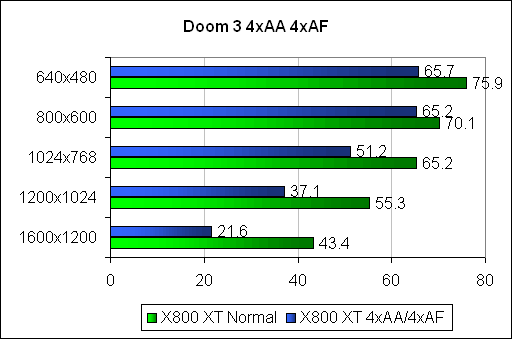
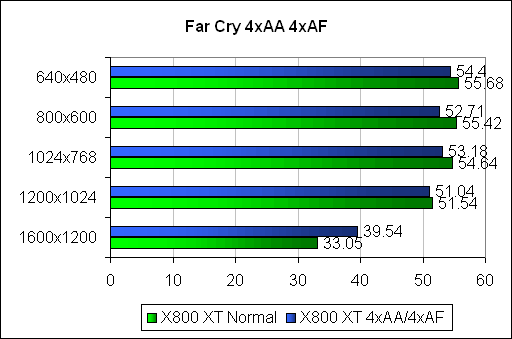
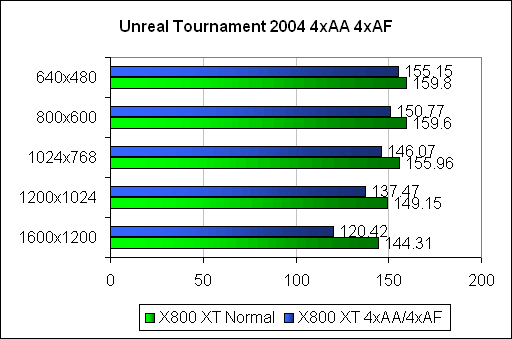
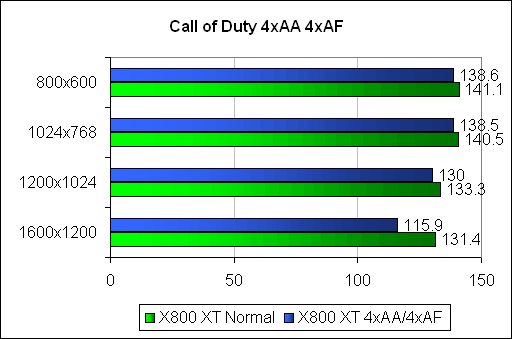
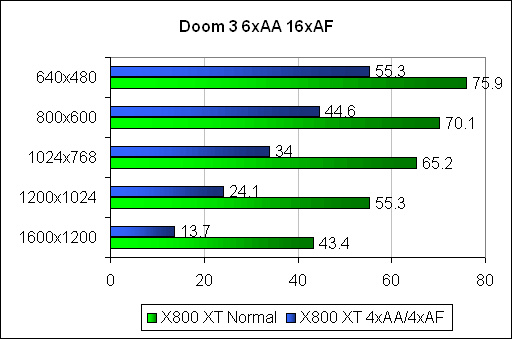
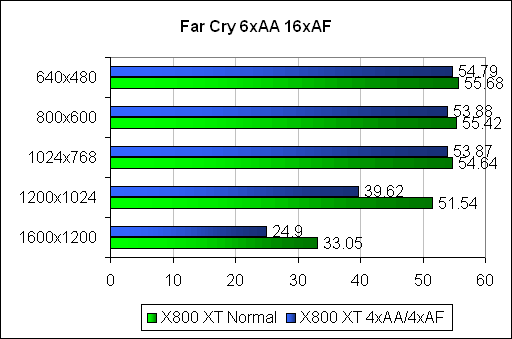
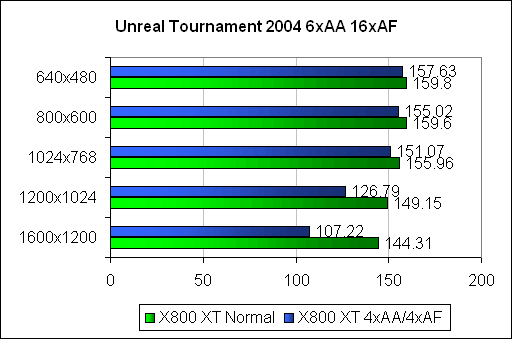
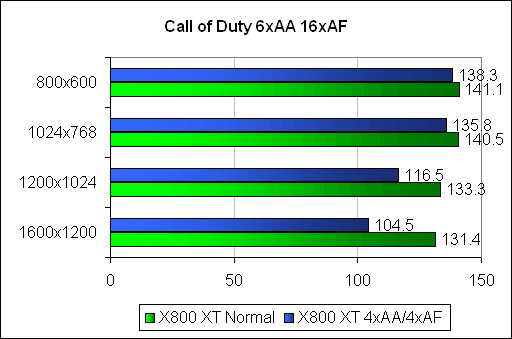
Overall, the Sapphire X800 XT is a solid performer. If you’re one of those that has to have the best and ATI’s your brand, this is the card to get. You probably won’t be able to find a PE edition so the XT is the closest you’ll get for now. You only need one Molex connector and it’s a single slot solution; something that’s important for those trying to build a heavy duty SFF game machine. Sapphire’s bundle is very nice and they make solid cards. It’s definitely going to set you back a good amount of money.

The X800 XT from Sapphire is a pretty vanilla card. I’d like to see the Toxic treatment given to this card but right now the only one available is the regular edition. Looking at the card, it would be hard pressed to see the differences between the XT and Pro edition if not for the fact that on the back of the card, there is a small sticker specifying that it is an XT model. The cooling solution is pretty standard here as well.
As far as the specifics of the card, the X800 XT features the full 16 pipes unlike the 12 pipes that is available in the X800 Pro card. Clock frequencies are at 500MHz core and 500MHz memory. Speeds are moderately less than the Platinum Edition and you can see the comparison below along with the X800 Pro in the picture.

One of the nice things about Sapphire’s offerings are the bundles and the X800 XT card I received features their latest bundle that wasn’t in the initial X800 Pro card that Sapphire sent me. Two great games, Splinter Cell: Pandora Tomorrow and Prince of Persia: Sands of Time are included along with a good software suite. That’s two well received game that’s a great addition to anyone’s library.
AMD64 3200+
2 - 256MB PC3200 ram from Crucial
ABIT KV8-MAX3 motherboard
Maxtor 200GIG 7200 RPM harddrive
Windows XP Professional with Service Pack 1
Catalyst 4.9
For this review I’m going all game benchmarks, no synthetic benchmarks. First up will be a new one to our lineup: Doom 3

Doom 3 is iD Software’s re-invention of the classic game that started the deathmatch craze. The engine really taxes a system and the graphics are phenomenal for a computer game. For the tests, we ran the game with Max settings here.

While the bottleneck is the CPU at 640x480 with both cards running neck and neck, you can see the X800 XT’s power show as we increase the resolution. The X800 XT runs almost 10fps more at 1600x1200 than the X800 Pro.

Far Cry is an impressive first person shooter from Ubi Soft with great outdoor levels and some awesome effects. The vehicles and the ability to explore the entire island makes this one of the best games of the past year. Settings were maxed out and we used the default demo.

At low resolutions, the two cards are running at pretty much the same speed. Only when we start upping the resolution do we see the X800 XT pull away.

Halo is the Microsoft/Bungie/Gearbox first person shooter originally appearing on the Xbox. Featuring great graphics, vehicles, and good gameplay Halo is ran with max settings as well with Pixel Shader 2.0.

The X800 XT keeps an average of 60 fps at 1600x1200 and almost keeps pace with the X800 Pro running at 1280x1024.

If there’s one game I really enjoyed the past year it’s Call of Duty. The squad combat and action really excelled in this game. For this test, the settings were set at max and we ran the default demo in the various resolutions.

There really isn’t much separating the two cards as the game looks like it’s more CPU dependent at this point.

Epic’s great shooter, Unreal Tournament 2004 is our next test. While the engine didn’t change too much from the previous version, it’s still a very nice looking game. Three bot matches were ran with the scores averaged for each resolution. Details were maxed out.

Like with Call of Duty, both cards ran the game pretty well and scores were close to each other. We should see a difference between this and Call of Duty as we move into the anti-aliasing and anisotropic filtering tests later in this review.

Our final test is Splinter Cell from Ubi Soft. The third person stealth game uses a modified Unreal engine. Default demo was used for this test and the details were maxed out.

Not much increase in performance can be seen here in the lower resolution as there was roughly less than 5fps in each resolution. The difference does jump a little to 8fps as the resolution hit 1600x1200 though.
Now we’re moving on to performance with anti-aliasing and anisotropic filtering turned on. Here I ran four games and you’ll see how much of a performance loss you get at both 4xAA with 4xAF and 6xAA with 16xAF.








Overall, the Sapphire X800 XT is a solid performer. If you’re one of those that has to have the best and ATI’s your brand, this is the card to get. You probably won’t be able to find a PE edition so the XT is the closest you’ll get for now. You only need one Molex connector and it’s a single slot solution; something that’s important for those trying to build a heavy duty SFF game machine. Sapphire’s bundle is very nice and they make solid cards. It’s definitely going to set you back a good amount of money.
It's damn expensive but if you run games at a high resolution and have money to burn then this is the card to get.
Rating: 8.9 Class Leading
* The product in this article was sent to us by the developer/company.

About Author
I've been reviewing products since 1997 and started out at Gaming Nexus. As one of the original writers, I was tapped to do action games and hardware. Nowadays, I work with a great group of folks on here to bring to you news and reviews on all things PC and consoles.
As for what I enjoy, I love action and survival games. I'm more of a PC gamer now than I used to be, but still enjoy the occasional console fair. Lately, I've been really playing a ton of retro games after building an arcade cabinet for myself and the kids. There's some old games I love to revisit and the cabinet really does a great job at bringing back that nostalgic feeling of going to the arcade.
View Profile